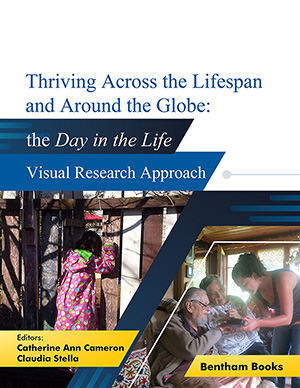Introduction
Page: 3-56 (54)
Author: Keith V. Bletzer
DOI: 10.2174/9781681081045115010004
PDF Price: $15
Abstract
This chapter provides an overview of the monograph, grounded in extended ethnography; describes the rationale for its format; outlines basic characteristics of primary and secondary field sites; explains the purpose served by selecting life story excerpts from 24 randomized narrators; summarizes the story behind the monograph’s title; presents snippets of “people in the data” through extreme cases and events that extend beyond structural vulnerability into experiences much like our own, yet more severe in social adversity. Two monograph data sources are described, the Migrant Worker Risk Study and the Drug Use Onset Study. In the latter project, Narrative Life Stories were taped and transcribed. Men and women currently or once active in farm labor comprise the sample of 127 narrators, who at the time of their interview were using or had previously used drugs and/or alcohol.
Down Home
Page: 57-102 (46)
Author: Keith V. Bletzer
DOI: 10.2174/9781681081045115010005
PDF Price: $15
Abstract
This chapter focuses on the home-base community’s staging area, where men and women interact in small-group clusters, seek work or secure transportation to farmlands surrounding Agton. The staging area provides settings for comradery, exchange of information on future work, and access to stores and taverns. I describe the history and current circumstances of Agton, and through data from extended ethnography, explore the rootedness of “players” in and around the staging area. Despite their structural vulnerability, farm workers in Agton express an amiability in these settings that supports an evolved strategy for defusing potential violence and avoiding fights in downtown streets and bars.
The chapter introduces Quentin and Anna among several users who were players around Agton, and ends with a description of two brothers, Lanton and Payson. One field note snippet (like the life stories, also randomized) includes Anna and Quentin as cluster participants. Each of these two individuals, and others such as Howard, had a unique style that represents the divergence in social interaction within the street life of the small town of Agton. Each was respectful of other men and women the many times that I observed and interacted with them in the staging area of Agton.
Distanced
Page: 103-133 (31)
Author: Keith V. Bletzer
DOI: 10.2174/9781681081045115010006
PDF Price: $15
Abstract
This chapter opens with elaborated field notes from a primary site a few hours from Agton, where the author spent time with sex workers who canvassed local neighborhoods, in addition to street solicitation for “dates” that paid for sexual services. In some ways the site is typical of a seasonal locale to which farm workers travel onthe- season, and home-base from which they migrate to other areas. The example leads the reader into an appraisal of classic ethnographies in the social sciences that exemplify fieldwork on social adversity and marginality in single-site urban locales, against extended ethnography through multi-sited fieldwork among farm workers across several locales. Core elements are reviewed that characterize everyday matters in each form of ethnography, namely, transportation, sports, swearing, drugs, alcohol, dating, and ethnographic process. Each element in one way or another enables ethnographer (field)/author (text) to share the experience of immersion into the field site, which led to strategic social relationships. Shifting among locales and settings in the ethnography of farm labor in contrast enables entry into a new site with cumulative information newly learned in other sites to that point in time, which also leads to strong social relationships with key people.
The chapter opens as I begin a day of observations, spending time around a convenience store where migrant men and local residents make purchases and sex workers spent time singly or in pairs, when not “working”. The women called the store owner, “Mom”. They sometimes share problems with her. One of the sex workers, Zubira, is introduced in the excerpt that opens the chapter, which illustrates how fieldwork requires flexibility and patience, acceptance of others, and attentiveness to interactions.
Moving About
Page: 135-169 (35)
Author: Keith V. Bletzer
DOI: 10.2174/9781681081045115010007
PDF Price: $15
Abstract
This chapter explores disproportionate mobility, given the precarious conditions of agrarian society, which requires workers willing to travel, perform physical labor, and forego advanced training that inhibits potential advancement. Most workers learn the basic skills for routine tasks; a few become crew chiefs who recruitmanage- supervisor farm labor, and/or own vehicles for transporting and/or property for housing workers. Very few ever own a farm. Against this backdrop, individual farm workers experience physically demanding labor that can lead to self-medication and risk-taking with drug and alcohol use, and accessing sex workers in the absence of lifelong companions. The chapter describes socio-economic mobility based on “settlingin”, “settling-out”, and “migratory farm labor”, and explores several places that became icons for farm labor in public memory and popular literature. Six cases illustrate settling-in and settling-out. Three individuals remained in the same rural county where they were raised (Sibel and Len Moise in Lower South, Propel in Middle South), one returned to his childhood home after military service (Morse in Middle South), one lived in several areas before he brought his wife and three children from another country and made a home for them in the eastern United States (Polo in Middle South), and one case of father-son farm ownership in the Midwest.
Aggregating
Page: 171-218 (48)
Author: Keith V. Bletzer
DOI: 10.2174/9781681081045115010008
PDF Price: $15
Abstract
This chapter is based on fieldwork at the edge of another primary site farm town. Men and women arrived for a perishable crop split season, left for one-three weeks, before returning to harvest the crop many had planted. Observations over two summers reveal timing required for disaggregation at the end of the first half (split season) and full season, when the work has been finished. Sometimes expenditure of resources left one with little food and no foreseeable employment. Group members who gather in clusters become inter-dependent on each other. For gatherings observed in this site, groups included a mix in backgrounds with an affinity for farm labor, as the main reason for aggregating, which emphasizes readiness for labor, however brief it might be, when the opportunity is offered.
Main players are introduced among those who spent time at The Market at the edge of the farm town. Exploring the formation of clusters, several dozen individuals are mentioned, including pinhook workers (Borado, Cien, Indigo, Juarez, Luis, Neto, Pastor, Taro), contractors (Geraldo, Hectór, Placido, Ricardo), re-settled migrants (Doñoni), local women (Kirabo, Pixel) and men from the town (LA and Walker), drug users (Santo) and distributors (Stanton), men passing-through (Vasco), watchman for The Market (Arary) and its two originators (Chano and Nacho), among others.
Street Life
Page: 219-241 (23)
Author: Keith V. Bletzer
DOI: 10.2174/9781681081045115010009
PDF Price: $15
Abstract
This chapter examines what farm workers do in a home-base community when not working, before or after work for a job they have, or when not currently employed. Field data extend the theme of home-base explored in Chapter 2 by comparing the time that workers spend in clusters (field notes) with drug use (survey protocols). Outdoor clusters bring together men and some women under the conditions of camaraderie, when these individuals are not waiting for a ride that requires a demeanor of labor readiness. Talking is the main activity in cluster formations, which brings out participant sociability. Among concerns discussed in these gathering is where and how to secure and sustain work. Where drugs can be secured is less often voiced in public, because most those present are non-users or those who limit their consumption to alcohol, which takes place more often at living sites than around the staging area. When participating in clusters, drug users readily “mix” with non-users.
The chapter opens with a synopsis of four types of drug transactions in agricultural communities, which were encountered in breadbaskets where extended ethnography was conducted. These practices are linked to the cultural traditions of individuals who live and work in farming communities.
Drugging
Page: 243-324 (82)
Author: Keith V. Bletzer
DOI: 10.2174/9781681081045115010010
PDF Price: $15
Abstract
This chapter focuses on first times that are socially noteworthy and personally memorable, dependent on who one wishes to emulate or what one wishes to explore/experience. For some individuals these “firsts” emphasize drug use, often associated with experimentation in growing-up. For men and women in the sample of 127, these events they remembered, such as first drug ever used, each new drug used thereafter for the first time, the last time that a new drug was initiated, and juncture in a life-long narrative, when someone “ceased using” and gained sobriety.
This chapter introduces 24 randomized narrators, beginning with Arnie, who had no experience with drugs or alcohol, when he first entered the United States. The snippets for each of the twenty-four describe lifetime drug repertoires, significant remembrances covered in their Narrative Life Story, and a truncated appraisal of their structural vulnerability experienced throughout their lifetime. The chapter opens with a rhetorical scenario of common first times for most everyone.
Canvassing
Page: 325-374 (50)
Author: Keith V. Bletzer
DOI: 10.2174/9781681081045115010011
PDF Price: $15
Abstract
This chapter explores commercial sex work in farming areas, utilizing materials prepared for workshops at migrant stream conferences, attended by frontline migrant service workers. The existence of sex work in areas where farm workers predominate underscores practices of gendered exclusion, which compels local women into survival sex and generates opportunity structures for trafficking. The field materials cover examples of sex work as it occurs in agricultural areas. Many of the women once performed farm labor (a few still do), but gradually left it, as their structural vulnerability compelled shifting into new roles and their corresponding drug use escalated.
This chapter concludes with a discussion of sex work as an example of the consequences that result from few opportunities of meaningful work for women, general attitudes towards women that lead to gray zone practices, and willful neglect that allows sex work in rural farming communities.
Activity Sex
Page: 375-423 (49)
Author: Keith V. Bletzer
DOI: 10.2174/9781681081045115010012
PDF Price: $15
Abstract
This chapter continues the theme of first times by focusing on “sexual debut” (first sex). Material covers first sexual relations remembered by the 24 randomized narrators. Similar to new drug use, most narrators first had sex in their hometown – similar to the full sample – usually before they were traveling on-the-season for farm labor. Most first partners were close in age from the same school or neighborhood (United States) and village or rancho (Central America), or someone met casually at a local dance or public place such as a community park (United States) or bar or tavern (outside the United States). Those experiencing sex for the first time usually were younger than their partners, which meant that most of the opposite-sex and same-sex partners had prior experience.
Rare few were still with their first partner. Many men and some of the women if they were sex workers (among both narrators and full sample) were outside the parenting process for their children, which identifies one consequence stemming from their structural vulnerability. A few had no idea of current whereabouts of their first partner or their children from this person or subsequent partners.
Consuming
Page: 425-447 (23)
Author: Keith V. Bletzer
DOI: 10.2174/9781681081045115010013
PDF Price: $15
Abstract
This chapter reviews the literature on food and consumption, and explores “eating” as an under-publicized activity performed by men and women in agriculture. Responses from the last section of the Narrative Life Stories are examined, “When you think of sex, what food do you think of?” These responses reveal narrator viewpoints on a hypothetical relationship between food and sex that provide a glimpse at the economically precarious challenges regularly faced by farm workers. Workers in traveling on-the-season constantly re-constitute the imaginary community in which they live.
Exploring responses to the interview question shows how farm workers blend consumption of foods from cultural groups in the southern United States, emphasizing regional commonalities. Distinctions based on gender in contrast were found to be more noticeable as distinctive within the field materials.
Climb Up
Page: 449-486 (38)
Author: Keith V. Bletzer
DOI: 10.2174/9781681081045115010014
PDF Price: $15
Abstract
This chapter explores some behind-the-scenes aspects of fieldwork (team viewer approach). Presentation of the material serves as a textual break between the conclusion and the first ten chapters that examine facets of agricultural labor and drug/alcohol use. The chapter narrates a few situations experienced by the fieldworker, where encounter with law enforcement took place for whatever reason. A big idea in the later portions of the chapter is the strategy basic to ethnography of spending engaged time with “research subjects”.
Conclusion
Page: 487-522 (36)
Author: Keith V. Bletzer
DOI: 10.2174/9781681081045115010015
PDF Price: $15
Abstract
The final chapter pulls together materials from previous chapters, examines the occurrence of gray zone practices in agriculture as evidence of marginalization and structural vulnerability, and identifies similarities between farm labor and the model of bare life proposed by Giorgio Agamben. Farm labor was one of the last occupations in North American society to receive legislated protections, which have yet to reach the allencompassing provisions of other labor categories. Willful negligence was strongest when agriculture began implementing industrialized labor practices, resulting in severe difficulties and horrendous experiences faced by farm workers. Despite a few protections mostly in worksite safety and housing, enforcement of statutes is typically inconsistent. Shifting attitudes toward those who are undocumented, and insulation of minority workers in agriculture, complement strategies of willful negligence. Both continue and magnify worker susceptibility to drug/alcohol abuse, owing to their structural vulnerability and the existence of few socio-legal supports for improved conditions.
Despite the role they play in generating the foodstuffs on which we rely for the survival of our species, farm workers are too often denied the full respect they deserve for what they do under unforgiving circumstances. There must be a better way than drugs/alcohol to pay respect and honor their labor ....
Appendix A: Randomized Narrators
Page: 549-550 (2)
Author: Keith V. Bletzer
DOI: 10.2174/9781681081045115010017
PDF Price: $15
Appendix B: Sampled Respondents
Page: 551-551 (1)
Author: Keith V. Bletzer
DOI: 10.2174/9781681081045115010018
PDF Price: $15
Appendix C: Representing Farm Labor
Page: 553-554 (2)
Author: Keith V. Bletzer
DOI: 10.2174/9781681081045115010019
PDF Price: $15
Appendix D: Farm Worker Networks
Page: 555-556 (2)
Author: Keith V. Bletzer
DOI: 10.2174/9781681081045115010020
PDF Price: $15
Appendix E: Attire and Desire
Page: 557-558 (2)
Author: Keith V. Bletzer
DOI: 10.2174/9781681081045115010021
PDF Price: $15
Appendix F: Caper at Sam’s Tavern
Page: 559-560 (2)
Author: Keith V. Bletzer
DOI: 10.2174/9781681081045115010022
PDF Price: $15
Appendix G: Narrative Life Stories
Page: 561-564 (4)
Author: Keith V. Bletzer
DOI: 10.2174/9781681081045115010023
PDF Price: $15
Appendix H: Field Note Conversion
Page: 565-568 (4)
Author: Keith V. Bletzer
DOI: 10.2174/9781681081045115010024
PDF Price: $15
Appendix I: Drug/Alcohol Use in Labor Camps
Page: 569-569 (1)
Author: Keith V. Bletzer
DOI: 10.2174/9781681081045115010025
PDF Price: $15
Appendix J: Mapping U.S. Farm Labor
Page: 571-574 (4)
Author: Keith V. Bletzer
DOI: 10.2174/9781681081045115010026
PDF Price: $15
Appendix K: Theoretical Methodologies
Page: 575-576 (2)
Author: Keith V. Bletzer
DOI: 10.2174/9781681081045115010027
PDF Price: $15
Glossary
Page: 593-594 (2)
Author: Keith V. Bletzer
DOI: 10.2174/9781681081045115010028
PDF Price: $15
Introduction
Based on six years of extended ethnography in multiple agricultural areas of the Eastern United States, Down Country Lanes, Behind Abandoned Houses is a monograph which explores the lives of migrant and seasonal farm workers. The six-year study secured multi-setting field data in primary, secondary and casual sites, and audio-taped narrative life stories from men and women who harvest and perform the related tasks that help to make the many foods which we enjoy in abundance. The study presented in this book elaborates vignettes from field observations with a focus on workers who use drugs and alcohol, and is complemented by formal (narrative life stories) and informal interviews. The author explores diverse field data that reveal the hardships, exclusion and social adversities that migrant farm workers experience many times more often than any other social group with considerable susceptibility to drug / alcohol use. Down Country Lanes, Behind Abandoned Houses gives readers a perspective about farm workers’ social vulnerability across multiple agricultural areas, while comparing willful neglect and social non-existence experienced by farm workers to a gray zone of contemporary horrors in the way that these men and women have been viewed and treated over many decades. The monograph is an invaluable reference for the study of social problems, substance abuse, trans-national migratory experiences and field methods in sociology. The book also serves as a contemporary handbook on the anthropology of American agricultural labor.













